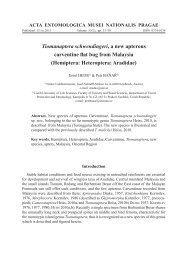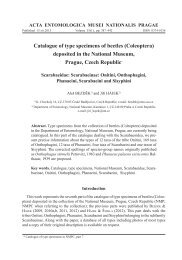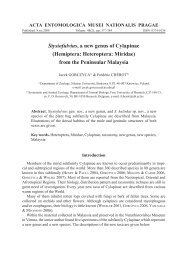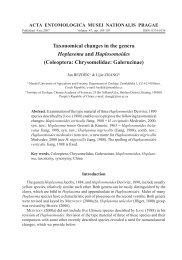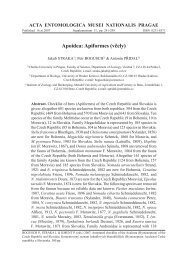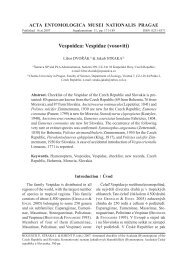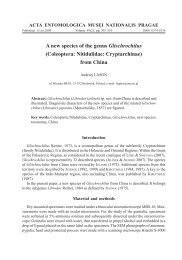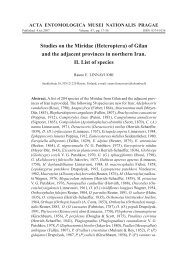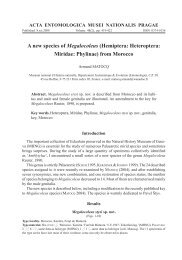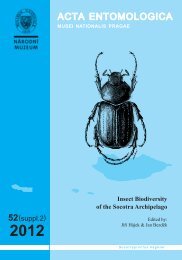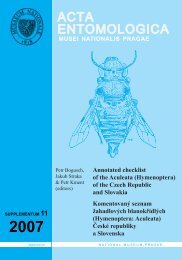Revision of the Palaearctic species of the Coccinella ...
Revision of the Palaearctic species of the Coccinella ...
Revision of the Palaearctic species of the Coccinella ...
Create successful ePaper yourself
Turn your PDF publications into a flip-book with our unique Google optimized e-Paper software.
130<br />
KOVÁŘ: <strong>Coccinella</strong> transversoguttata <strong>species</strong> group and notes on o<strong>the</strong>r <strong>Coccinella</strong><br />
were listed in several catalogues published at <strong>the</strong> beginning <strong>of</strong> 20th century; <strong>the</strong> distribution <strong>of</strong><br />
30 <strong>Palaearctic</strong> <strong>species</strong> was given e.g. by JACOBSON (1915).<br />
DOBRZHANSKIY (1925) laid <strong>the</strong> foundations <strong>of</strong> <strong>the</strong> modern classification <strong>of</strong> <strong>the</strong> genus <strong>Coccinella</strong>;<br />
he was <strong>the</strong> first to precisely define essential characters <strong>of</strong> <strong>the</strong> genus, using peculiarities<br />
in <strong>the</strong> colour pattern and especially in <strong>the</strong> structure <strong>of</strong> male and female genitalia to separate<br />
<strong>the</strong> genera Synharmonia Ganglbauer, 1899 (now Oenopia Mulsant, 1850) and Coccinula<br />
Dobrzhanskiy, 1925. Later, he treated 12 <strong>Palaearctic</strong> (DOBRZHANSKIY 1926) and 10 Nearctic<br />
<strong>species</strong> (DOBRZHANSKIY 1931) <strong>of</strong> <strong>Coccinella</strong> using characters on male and female genitalia,<br />
mostly figured for <strong>the</strong> first time. DOBRZHANSKIY (1926) defined <strong>the</strong> typical colour-pattern <strong>of</strong><br />
<strong>Coccinella</strong> and named particular elytral spots. In <strong>the</strong> second work, DOBRZHANSKIY (1931)<br />
analytically compared North American <strong>species</strong> with <strong>the</strong> <strong>Palaearctic</strong> ones and subdivided <strong>Coccinella</strong><br />
into six <strong>species</strong> groups according to <strong>the</strong> similarities in <strong>the</strong> shape <strong>of</strong> <strong>the</strong> median lobe <strong>of</strong><br />
aedeagus. Although <strong>the</strong> groups were not strictly defined at that time, and, consequently, only<br />
slightly influenced <strong>the</strong> approach <strong>of</strong> fur<strong>the</strong>r students in <strong>Coccinella</strong>, this subdivision may be,<br />
with some corrections and additions, accepted also at present. The splitting <strong>of</strong> <strong>Coccinella</strong> into<br />
three genera by DOBRZHANSKIY (1925) was followed by MADER (1926-1937), who redescribed<br />
18 <strong>Palaearctic</strong> <strong>species</strong> <strong>of</strong> <strong>Coccinella</strong> using chiefly coloration, which lead him to describe<br />
many new aberrations and incorrect interpretation <strong>of</strong> some taxa <strong>of</strong> subspecific rank as he<br />
neglected <strong>the</strong> genitalic characters. KORSCHEFSKY (1932) catalogued all <strong>species</strong> <strong>of</strong> <strong>Coccinella</strong>,<br />
giving <strong>the</strong>ir synonymy, extensive list <strong>of</strong> infrasubspecific names, complete bibliography and<br />
known distribution. However, his concept <strong>of</strong> <strong>the</strong> genus was extremely wide and many unrelated<br />
taxa were included as subgenera. Moreover, he did not respect <strong>the</strong> original status <strong>of</strong> some<br />
infrasubspecific names. Fur<strong>the</strong>r valid <strong>Palaearctic</strong> <strong>species</strong>, classified now as true <strong>Coccinella</strong>,<br />
were described by SEMENOV & DOBRZHANSKIY (1923), DOBRZHANSKIY (1927a), OHTA (1928),<br />
LIU (1962), KAPUR (1963, 1973), MIYATAKE (1963), LEWIS (1967) and IABLOKOFF-KHNZORIAN<br />
(1970b). Several o<strong>the</strong>r papers dealt with <strong>the</strong> taxanomy <strong>of</strong> <strong>the</strong> genus. FILIPPOV (1961) studied<br />
<strong>the</strong> variability in <strong>the</strong> colour pattern <strong>of</strong> elytra in <strong>the</strong> Coccinellidae. He illustrated a complete set<br />
<strong>of</strong> colour patterns <strong>of</strong> elytra in 8 <strong>species</strong> <strong>of</strong> <strong>Coccinella</strong> and compared <strong>the</strong>m with some o<strong>the</strong>r<br />
<strong>Palaearctic</strong> genera. He proposed <strong>the</strong> generic name Miliziella Filippov, 1961 for Semiadalia<br />
turkestanica Semenov & Dobrzhanskiy, 1923 (classified now in <strong>Coccinella</strong>). BROWN (1962)<br />
revised <strong>the</strong> <strong>Coccinella</strong> occurring in North America north <strong>of</strong> Mexico, corrected <strong>the</strong> nomenclature,<br />
subspecific concept <strong>of</strong> some <strong>species</strong> including C. transversoguttata, described one new<br />
<strong>species</strong>, and gave precise distributional data and a valuable key. In addition, BROWN (l967)<br />
published a review <strong>of</strong> <strong>Coccinella</strong> recorded by various authors from Mexico, among <strong>the</strong>m C.<br />
nugatoria Mulsant, 1850 and its sub<strong>species</strong> sonorica Casey, 1908, which he considered to be<br />
a valid <strong>species</strong>. SAVOYSKAYA (1969), using <strong>the</strong> morphology <strong>of</strong> larvae and male genitalia, subdivided<br />
<strong>Coccinella</strong> into two subgenera: <strong>Coccinella</strong> s. str. and Neococcinella Savoyskaya,<br />
1969. The subgenus Neococcinella fully corresponds with <strong>the</strong> C. undecimpunctata <strong>species</strong><br />
group proposed by DOBRZHANSKIY (1931). The same taxon was erected also by IABLOKOFF-<br />
KHNZORIAN (1970a) under <strong>the</strong> name Dobzhanskia Iablok<strong>of</strong>f-Khnzorian, 1970. Authors <strong>of</strong> both<br />
papers declared C. undecimpunctata Linnaeus, 1758 as <strong>the</strong> type-<strong>species</strong>. In his review<br />
IABLOKOFF-KHNZORIAN (1979) gave <strong>the</strong> key characters <strong>of</strong> <strong>Coccinella</strong> which he divided into<br />
four subgenera as he i) retained Neococcinella with 3 <strong>species</strong> and synonymized Dobzhanskia



